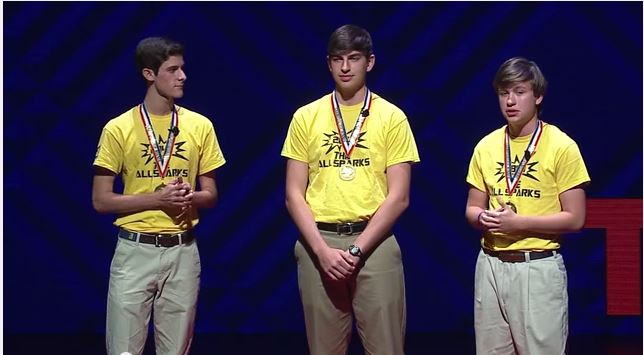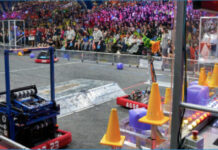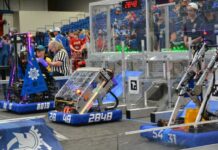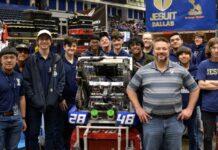Walking down the halls or sitting in class, students might not realize that among them are a grou of World Champions. These people aren’t seen out on the football field or in the locker room, discussing plays and training. They instead meet in the machine shop to discuss blueprints and programming solutions. This group is Jesuit’s World Champion Robotics Team 2848, who recently presented a TEDx talk at SMU on November 1st. Kieran Celli ’15, Ben Ovenshire ’15, and Drew Curran ’15 spoke about their team’s journey from 72nd to 1st at the Robotics World Championships.
“At noon on April 26th 2014, we were only ranked 72nd out of 100 teams at the Robotics World Championships. About 5 hours later, we were standing in the middle of the field wearing these gold medals and surrounded by thousands of screaming spectators. How did we get from 72nd to first?” opened Ovenshire.
The seniors reflected back on where their path to success began, long before the day of the championships, the day they qualified, or even the day they entered in January. “It started a full year earlier. With our 32 member team, we sat down and decided that the 2014 season would have a new essence to it: teamwork,” Celii explained.
Drew Curran described the humble beginnings of the Jesuit Robotics Program 7 years ago. Starting with “6 students and one adult mentor working in a garage,” the team has grown to boast over 40 students and just under a dozen adult mentors. He went on to explain how the FIRST Robotics Competition, FRC in short, works. Teams are given a challenge in January, and have 6 weeks to create a robot that answers that challenge. The robots are placed in “regional competitions made up of qualification matches” that lead to “March Madness style elimination matches, with three teams from each region making it to nationals.”
Ovenshire then pointed out that this system isn’t the only similarity robotics shares with sports: “Just like on a sports team, each member has to know the game and practice… Everyone has a role, and they need to fulfill that role in order to succeed. This is where we were having trouble.”
With the old team dynamic, members weren’t all pulling their own weight, keeping the team from reaching full potential.
“Now for a little question for the audience. Can you guys raise your hand if you’ve been in a group project where you’ve had to do all the work by yourself?” Posed by Celii, the question incited laughter and a flurry of hands. “Now keep your hand raised if that’s just because everyone in the group didn’t know how to help you guys.”
“I came face to face with this problem freshman year. I really wanted to join Robotics because I saw all the amazing things my brother was doing with robotics and engineering. Unfortunately though, all I was able to do freshman year was fulfill the very prestigious role of Vacuum Captain,” explained Curran. “The problem was, the seniors never taught us, the underclassmen, what we needed to know to help. This created a vicious cycle of the seniors doing all the work, and us sitting on the side wondering what we could do to help because they didn’t have any time to teach us.” He highlighted the frustration of trying to learn by watching, but getting nowhere with so much going on.
Ovenshire continued the sports analogy by saying, “We were lacking teamwork to say the least. If we were a sports team, we would be the one that relies on three or four good players to pick up the slack for the rest of the team.” He described the hectic scene of seniors racing around a shop with half-finished projects while underclassmen just tried to stay out of the way.
After a lukewarm season, the team decided to break the cycle of inefficiency. Holding workshops and classes to help educate every member, the group tried to create a cohesive unit. This way, everyone could work together to build the best possible robot. With over 2000 man hours on the bot total, there was an average of 60 hours put in per member.
Celii touched on the idea of everyone working on something to more efficiently create the robot by describing his part as a member of the design team: “In the end, only one small part, a bracket on the side of the robot, ended up getting used from my original design. But it didn’t matter, because it symbolized what I contributed to help make the team successful.” He continued, “In the end, everyone contributing one small part made us so successful that today we stand before you as world champions.”
Curran looked to the future, saying “Despite all of the success we’ve had, the other seniors and I realize that we still have a long way to go with teamwork… We’re more dedicated than ever to make it a priority on our team.”
Ovenshire closed with a challenge: “We would love it if everyone had the same experience that we did. We challenge each of you to get involved in your community, and, more importantly, encourage the young people in your life to do the same… If you look at our team as an analogy, you are the seniors. And although it’s really important that you get involved in any way you can, it’s equally important that you work to help the young people in your lives to learn the goals and skills they will need in the future.”
The team then unveiled their T-shirt cannon for the audience. This, along with the full presentation, can be seen in the video below.
Their similar presentation for TEDxKids can be seen here.
When asked about his feelings on the experience, Celii “saw [the talk] as a great opportunity to not only represent our team and the success we had this year but to also talk to both the adults and kids about the importance of teamwork in their lives.” He also touched on the lead up to the speech, saying that he and his teammates “were all a little nervous after having spent months preparing for the talk. As for the audience, we were informed and somewhat overwhelmed by their wonderful engagement and their enthusiasm towards all of the presenters.”
He also spoke about expectations for the new season, saying that “because the challenge changes every year, our success is hard to predict. However, with the new changes to give our younger members more experience before the challenge is even announced and to create a more unified team, the team is looking well on its way to at least achieve a high standing at the championship.” He also mentioned that additional changes to the competition have been put in place, and said that just like “every season is, it will be something completely new and unexpected.”
Finally, on what he’d like students to know about the team, Celii expressed that “if anyone is interested in joining, even those who have no experience with robots, programming, or our team, please stop by as we are always welcome to and interested in more help for the coming year.”






